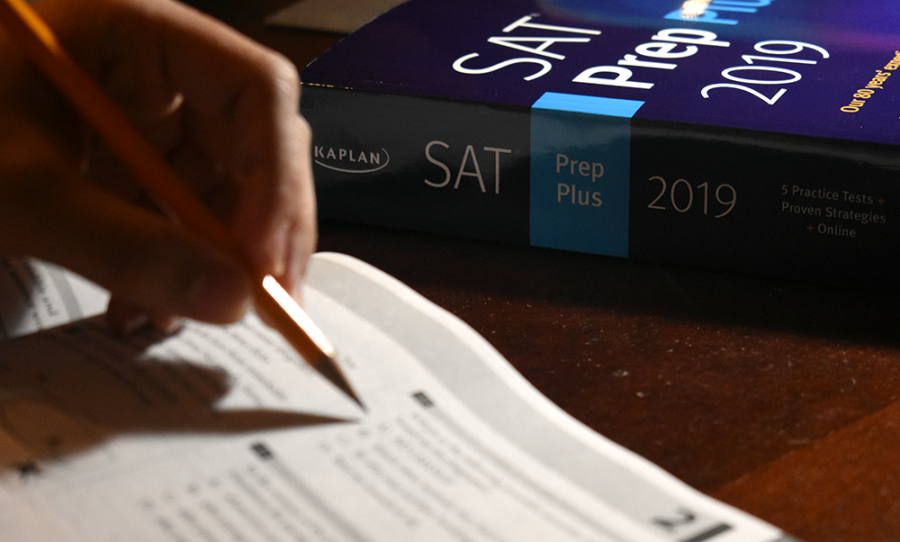Seven SAT Study Tips For the First SAT of the Year
According to Prep Scholar, studying for the SAT for at least 40 hours can help students improve their scores by roughly 70 to 130 points.
March 5, 2019
For many juniors across the country, March 6 marks the first time they will take the SAT. Notorious for consuming numerous hours of studying and making or breaking college applications, the SAT plays a huge role in the lives of many high schoolers. When preparing for the SAT, students should study hard but not stressfully. Read on for seven useful study tips to help you prepare for your first exam stress-free. (Because knowledge is power).
- Understanding the SAT format
- The SAT consists of three main sections: Reading, Writing and Math. In addition to the three sections of the exam, there is also an optional section for the 50-minute essay. The total testing time for the SAT, including the optional essay, is three hours and 50 minutes. The full breakdown looks like this:
- Reading – 65 minutes
- Writing – 35 minutes
- Math (With Calculator) – 55 minutes
- Math (Without Calculator) – 25 minutes
- Essay (Optional) – 50 minutes
- The SAT consists of three main sections: Reading, Writing and Math. In addition to the three sections of the exam, there is also an optional section for the 50-minute essay. The total testing time for the SAT, including the optional essay, is three hours and 50 minutes. The full breakdown looks like this:
- Practice timing yourself
- Preparing for the SAT is useless if test-takers rush through each section and put their heads down before time is up. In order to perform well on the day of the exam, students should become comfortable with the time constraints on each section of the SAT. The best way to set a time for each section taken during a practice exam. By simulating and becoming familiar with the conditions of the testing room, SAT test-takers can approach their exams with more confidence and less stress. A good rule of thumb is to finish a few minutes before time is up for each section in order to answer skipped questions, double check answers and fill in the bubble sheet.
- TIP: Wear or bring an analog watch to the testing room. Not all testing rooms will have clocks, and not all proctors write the time remaining for the exam on the board. By having a watch with you, you can better keep track of yourself during the exam in order complete the section before time is up.
- Know your resources
- In previous years, students taking the SAT often purchased study materials in the form of heavy, inches-thick books. Fortunately, all official SAT preparation materials can be found online for free. After the release of the New SAT, the College Board and Khan Academy joined together to offer free, in-depth SAT prep materials in order to make test prep more accessible. The College Board-Khan Academy partnership consists of tutorial articles and videos as well as full-length practice tests and a plethora of practice SAT questions that can be found here. Start studying for the SAT for free today by linking your College Board account with Khan Academy.
- Take a practice exam
- Students preparing for the SAT should take at least one practice test before exam day to expose themselves to the general contents of the SAT. Because SAT questions are pattern-based and repetitive, becoming familiar with the different types of test questions before the day of the exam can help students feel more comfortable when taking the actual test. Taking a practice exam can also help students identify what areas of the SAT they struggle with, so that they can study specific materials beforehand.
- Learn from your mistakes
- You’ve watched the video tutorials and taken multiple practice exams, but you’re still not getting the scores you want. What are you doing wrong? When preparing for the SAT, the most important content for students to focus on are the things they do not know because test-takers are more likely to miss questions for those subjects compared to the content they are already familiar with. Try reviewing questions answered incorrectly and understanding why each question was wrong. Was it because you misread the question? Did the wrong math? Or did you simply guess? After figuring out why a question was wrong, attempt to re-do the question and see if you can get the right answer before reading the explanation. The ability to identify what you missed and why will help you raise your SAT score by precious points and allow you to avoid silly mistakes made in the past.
- Making the essay easy
- While the essay section of the SAT is optional, test-takers should sign up for the essay just in case. (If a college requires the essay section, students will not have to retake the entire SAT.) For the SAT Essay, students should know how to: write a strong thesis, utilize the five-paragraph essay format, and cite and analyze textual evidence.
- The best way to approach the five-paragraph essay is to create an outline for the argument. Make sure that every reason identified is introduced by writing a topic sentence for each paragraph. (Essentially, a mini thesis statement.)
- Paragraph One: Introduction + Thesis Statement
- Paragraph Two: Reason #1 with text evidence
- Paragraph Three: Reason #2 with text evidence
- Paragraph Four: Reason #3 with text evidence
- Paragraph Five: Restate Thesis + Conclusion
- To write a strong one-sentence thesis statement, answer the prompt directly and clearly. Be specific with the ‘why’ of the thesis and also identify potential discussion points for reasons that support the thesis. (Use these potential discussion points to direct each of your body paragraphs.)
- The difference between a high-scoring SAT Essay and a low-scoring one is the use and analysis of textual evidence. For every claim made to support the thesis of the argument, students should use at least one piece of evidence to support that claim, then explain why the evidence from the text makes the claim stronger.
- TIP: Make sure that everything you write down for your essay relates back to the prompt and supports your thesis statement.
- Memorize basic math
- While the SAT offers a formula chart at the beginning of the Math section, becoming familiar with basic equations can save test-takers precious minutes when taking the exam. Students are encouraged to memorize basic math formulas although they are provided on the SAT formula chart sheet because not only does knowing the formulas save students time from flipping back and forth between the test booklet, but knowing basic math formulas also comes in handy because certain SAT Math problems cannot be solved by the formulas found on the formula sheet.








